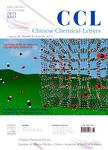Liquid crystal character controlled by complementary discotic molecules mixtures: Columnar stacking type and mesophase temperature range
Liquid crystal character controlled by complementary discotic molecules mixtures: Columnar stacking type and mesophase temperature range作者机构:State Key Laboratory of Polymer Physics and Chemistry Changchun Institute of Applied Chemistry Chinese Academy of Sciences Changchun 130022 China University of the Chinese Academy of Sciences Beijing 100049 China School of Materials Science and Engineering Zhengzhou University Zhengzhou 450052 China
出 版 物:《Chinese Chemical Letters》 (中国化学快报(英文版))
年 卷 期:2016年第27卷第3期
页 面:475-480页
核心收录:
学科分类:07[理学] 070205[理学-凝聚态物理] 08[工学] 080501[工学-材料物理与化学] 0805[工学-材料科学与工程(可授工学、理学学位)] 0703[理学-化学] 0702[理学-物理学]
基 金:supported by the National Natural Science Foundation of China(No.51303177) the Strategic Priority Research Program of the Chinese Academy of Sciences(No.XDB12020300)
主 题:Alkyl chains packing Mesophase type Liquid crystals Phase transitions Mixture
摘 要:In this work, the mesophase properties were tuned via mixing two discotic molecules with structural complementarity. Compared with the liquid crystalline hexakis(n-hexyloxy)triphenylene(H6TP)materials(columnar hexagonal phase from 53 ℃ to 91 ℃), mesophase types as well as phase transition temperatures varied with the introduction of crystalline hexaazatriphenylene derivative(PBH)molecules. The introduction of less than 33% amount of PBH disrupted the columnar hexagonal phase formed by H6 TP remarkably, followed by the decreased clearing temperatures of liquid crystals. As the PBH amount was further increased, the destroyed columnar hexagonal phase was turned into the columnar rectangular phase, in which H6 TP and PBH molecules together formed the columnar mesophase. The formation of new mesophase contributed to the enlarged mesophase temperature(from44 ℃ to 144 ℃). We speculated that the alkyl chains interaction induced by the PBH component competed with the strong p–p stacking between H6 TP molecules, thus altering the liquid crystalline properties including mesophase types and phase transition temperatures.



